At SJR Research, your history is more than a string of dates or a file of dusty records. Our experts harness the stories of your past to create compelling connections to the present day. Since 2005, our team has equipped enterprise-level corporations to genealogy hobbyists with the knowledge they need to turn their past into legacy-level narrative. Whether you’re looking for a few details to fill in your family tree or expert historical consultation for your next award-winning production, we can help.
Don't wanna be here? Send us removal request.
Text
Three Historical Cemeteries with Ghostly Pasts

Who doesn’t love a ghost story as we ramp up for Halloween? During October, thousands of Americans will tour graveyards for spooky thrills and chilling encounters. It should be no surprise that the most interesting (and eerie) locations to visit are also the most historic. Continue reading to discover the stories behind three historical cemeteries with ghostly pasts.
Charter St. Cemetery – Massachusetts
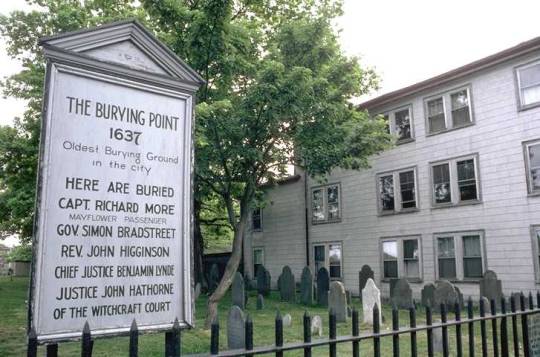
The Charter Street Cemetery, also known as the Old Burying Point Cemetery, was created in 1637, making it the oldest graveyard in Salem and one of the oldest in the country. Salem nobles and those who were enslaved are buried here, but only the nobles received tombstones. Many individuals involved in the infamous Salem witch trials of 1692-1693 were also laid to rest in this cemetery, including Judge John Hathorne, Bartholomew Gedney, and Eleanor Hollingworth.

Judge John Hathorne was the chief examiner of the witchcraft trials. Though he never completed any legal training, his status as a wealthy merchant landowner made him a trusted official. Throughout the trials, Hathorne always assumed guilt and interrogated the accused with cruel lines of questioning. His actions led to the hangings of nineteen innocent people. Even after the trials, when many who were involved regretted their actions, Hathorne felt no shame. Hathorne did in 1717 at the age of 76. His original headstone is still viewable, preserved by a large sheet of granite. Visitors claim that Hathorne's ghost fills the cemetery with a palpable feeling of dread.

The ghost of Mary Bright Corey, the second wife of Giles Corey, is also said to linger in the cemetery. Mary Bright Corey died in 1684, eight years before the witchcraft trials. Her husband, Giles Corey, was a successful farmer who had bad luck with women. Giles lost his first wife to disease. After the passing of his second wife, Mary, he married Martha. Martha became the victim of the witch hysteria; Giles even testified against her. Ironically, shortly after her death, neighbors accused Giles of also practicing witchcraft. Before Giles could be found guilty, he was squashed to death in his field by Sherrif Corwin.
Gettysburg National Cemetery – Pennsylvania
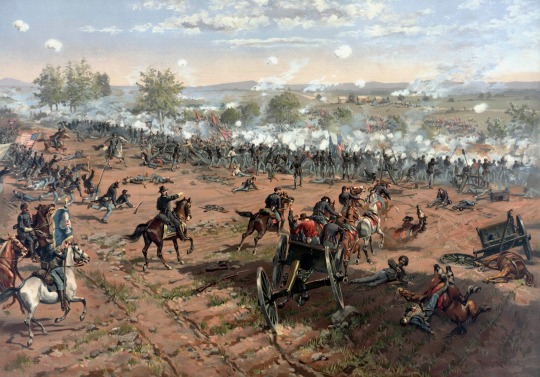
The Battle of Gettysburg was the bloodiest battle conflict ever fought in America. Over 40,000 men lost their lives. For days, the dead lay either on the battlefield or in shallow graves. Pencil writing on wooden boards randomly marked mass graves, but soon, rain began to erase identifications and erode the land. As you can imagine, the smell was so bad that residents held handkerchiefs dipped in peppermint and vanilla to their noses to block the stench. Local citizens began to fear that the countless bodies would spread disease, and they demanded a cemetery to bury the dead.
A committee was appointed to choose a site for the new burial ground. The Gettysburg National Cemetery is located where the Union army resisted Pickett’s charge. At the dedication ceremony, President Abraham Lincoln delivered his famous remarks now known as the Gettysburg Address.
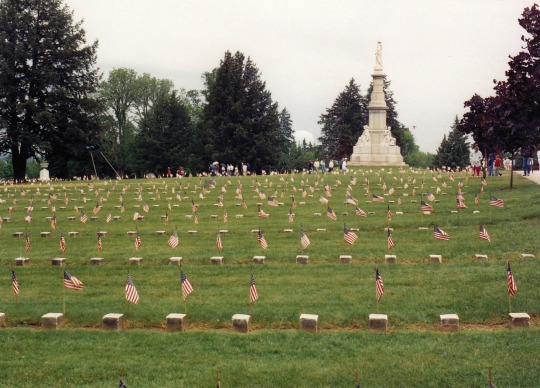
After the dedication, the Union soldiers were moved to the National Cemetery, but the Confederate soldiers remained in separate graves until they were taken back to the South in the 1870s. The National Cemetery contains the tombs of 979 unknown soldiers and thousands from the Civil War, World War I, and the Spanish American War.
It is no surprise that the site of our fallen heroes is the location of countless claims of paranormal activity. Many say they have witnessed ghosts marching around the cemetery and heard the sounds of cannons, screams, and gunfire. Others catch the smell of decaying bodies from centuries ago.
St. Louis Cemetery No. 1 – Louisiana
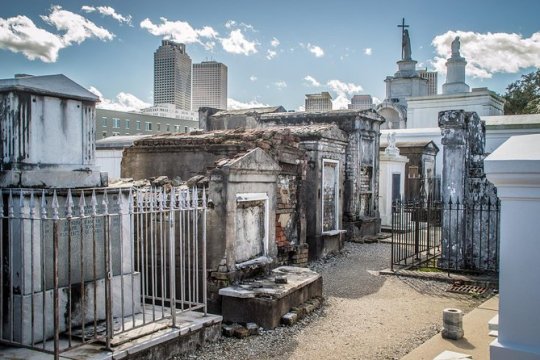
New Orleans is known for its spooky cemeteries, but visitors report the most creepy encounters at St. Louis Cemetery No. 1 in the French quarter. The cemetery is unique because of its above-ground tombs and the fact that it is still used for burials. The St. Louis cemetery is divided into three sections; the first was laid out at the end of the 18th century, and the other two were later created because of yellow fever epidemics.
The first cemetery section is the oldest and supposedly the most haunted. The Spanish governing officials established it in 1789 on a piece of land that was too swamp-ridden to build upon. The tombs found throughout are large because they contain multiple members of the same family. The cemetery features the graves of many notable citizens, including Etienne Bore, the first mayor of New Orleans, Homer Plessy, who challenged racial segregation in the supreme court, and Marie Laveau, famed voodoo doctor.
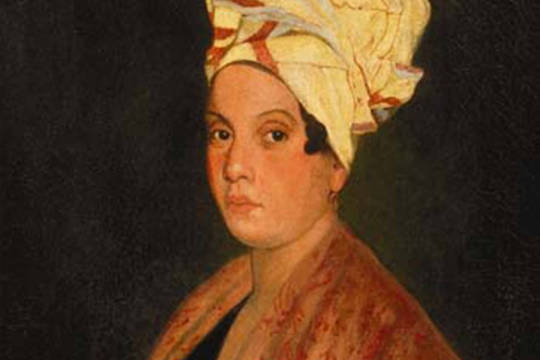
Laveau was born in 1801 in the French Quarter. She was a hairdresser by trade to aristocratic women, but she applied the knowledge of herbal remedies learned from her mother to become a successful voodoo practitioner. Supposedly, she cured and saved many citizens from yellow fever during the 19th century. Laveau is buried in plot 347 and often greets visitors in an unfriendly manner. There are reports of her spirit pinching arms and in some cases, even knocking people to the ground.
A sadder yet more friendly spirit by the name of Henry Vignes is also believed to roam the graveyard. Vignes was a 19th-century sailor who settled in New Orleans. As the story goes, Vignes owned important papers about his family’s tomb. Before he left on a voyage, he asked the owner of a boarding house to protect the documents. The owner instead sold Vignes’s family tomb. Vignes was not able to buy back the tomb and unfortunately died shortly after. Because he lost his family plot, he was buried in an unmarked grave. His ghost is frequently spotted at funerals searching for a place to rest.
Are you searching for family lore this Halloween?
We all have ancestors with stories to share, but unfortunately, many of their secrets remain hidden. Learn the history of your family tree by hiring one of our expert genealogists! Visit our website to start today!
2 notes
·
View notes
Text
The History of Lancaster, Pennsylvania

Lancaster, Pennsylvania, is an intriguing mix of modernity and historical preservation. As one of the first inland cities in the United States, it features America’s oldest continuously operating farmers market, a theatre built on the foundation of a pre-Revolutionary jail, and the county's first commercial pretzel bakery. This small town has more to it than vintage architecture. Continue reading below to discover Lancaster, Pennsylvania's role in history’s most crucial events.
American Indians and pioneers lay the town’s roots.

Before Europeans set foot on the land, Indian American tribes, including the Lenape, Mohawk, and Susquehannock, resided in the Lancaster area. The Susquehannocks were notable warriors with members who stood as tall as seven feet. Though they were known for their ferocity, the relationship between them and the Europeans was peaceful. Trading posts were set up along the Susquehanna River as early as 1630. The English and French pioneers traded weapons, blankets, liquor, and beads to the Indian Americans for furs.
Meanwhile, in England, William Penn was facing oppression for his Quaker beliefs. He had been kicked out of Oxford University, banned from his house, and jailed for eight months in the Tower of London. In 1681, King Charles II repaid a debt owed to Penn’s family by giving him land in America. Penn and his Quaker friends traveled across the pond and created the colony of Pennsylvania, which means Penn’s Woods. In 1683 and again in 1718, Penn expanded his colony by purchasing land from the American Indians. The growth of the colony attracted more individuals to travel to Pennsylvania.
The first settlers of present-day Lancaster arrived in Philadelphia in 1710. The group consisted of 29 Swiss Mennonites and was made up of several families. They were known as the Pennsylvania Dutch, as they had traveled through Germany and Holland to England to escape religious persecution. Once they arrived in Pennsylvania, they walked on 60 miles on Indian trails to reach the untouched area known as Hickory Town, which is now Lancaster County. There, in the wilderness, they could afford to buy land.
Thieves, vagabonds, and ill people spark the need for a new county.
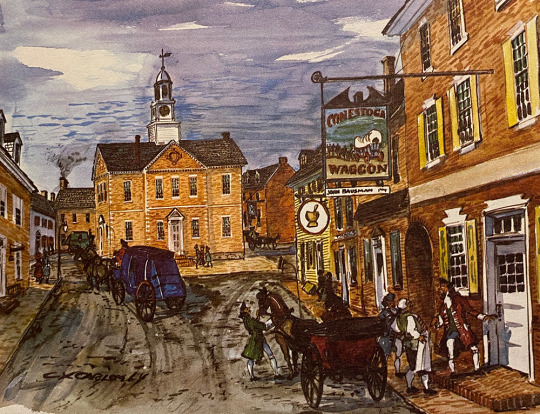
Almost two decades later, upper-class Englishmen complained that the area, which is now rural Lancaster, had been infested with “thieves, vagabonds, and ill people.” They requested a new county for a more civilized population. James Hamilton, the son of Andrew Hamilton, planned out the new city by drawing lots, and a local surveyor named John Taylor drew a division line to separate Lancaster from Chester County.
Lancaster received its name from John Wright, a notable member of the community. He called it Lancaster because he was originally from Lancaster, England. The city’s tie to Lancaster gave it the nickname of the “Red Rose City.”
Lancaster citizens were creative when it came to establishing their early governmental services. There was no courthouse so hearings were held in John Postlewaite’s tavern near the Susquehanna River. Sherriff Robert Barber built the community’s first jail cell in 1730 in his home. Lancaster became the county seat in 1729, a borough in 1742, and a chartered city in 1818. Lancaster did not officially become a city under the laws of Pennsylvania until May 27, 1924.
Christiana’s resistance fuels Civil War tension.

Christiana, a borough of Lancaster County, was known for being a frequent stop on the Underground Railroad. Due to its proximity to the Mason Dixon line and welcoming residents, fugitive slaves often sheltered there before traveling to Philadelphia or Canada.
Christiana is also the first place to show resistance to the Fugitive Slave Law. Under the law, fugitive slaves were to be arrested if found in the North, and anyone who helped them escape could be fined or imprisoned. In 1851, a year after the law was enacted, Edward Gorsuch, a plantation owner in Maryland, was tipped off that four runaway slaves were hiding in Christiana.
He located the enslaved individuals at the home of William Parker, a local fugitive who was known for helping the enslaved reach free states. When Gorsuch confronted Parker, almost 100 people came to Parker's defense. The altercation ended with Gorsuch being shot to death and 38 men arrested with treason.
The arrested men were found non-guilty in court, which sent a message to the South that the North would ignore their Fugitive Slave Law. Many historians point to this incident as the first spark of the Civil War.
Lancaster loses its bridge by saves its town.
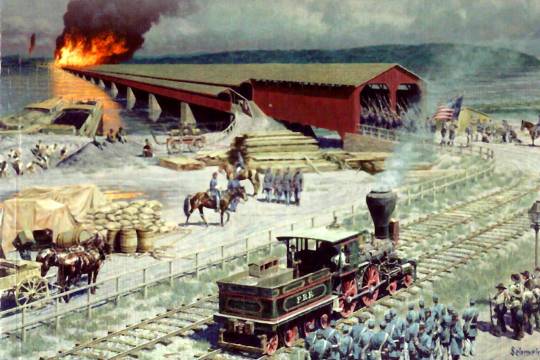
During the Civil War, Lancaster was home to many Black Americans and religious groups who supported abolition and aided the Union army, but in June of 1963, the city was in danger of a Confederate overtaking.
The Confederate Army was planning to capture Lancaster before advancing to Harrisburg. To combat their effort, hundreds of recently wounded Union soldiers partnered with the Pennsylvania military and a local Black militia company. However, they were greatly outnumbered and had to retreat from the approaching Confederate troops.
The only option that remained for stopping the Confederates was to sacrifice the Wrightsville-Columbia Bridge, an essential gateway for the local economy. By destroying the bridge, the Confederates would be unable to reach Lancaster. Colonel Jacob Frick gave an order to burn the bridge after an effort to explode it failed. Burning the bridge saved the town of Lancaster from the war and delayed the Confederates' journey toward Harrisburg.
What is your town’s story?
Every city has played a role in history, but many of their stories remain untold. Are you curious about your hometown’s past, or are you trying to spice up a real estate listing by showcasing nearby historical events? Visit our website to learn more about our property history services.
2 notes
·
View notes
Text
How to Celebrate Family History Month
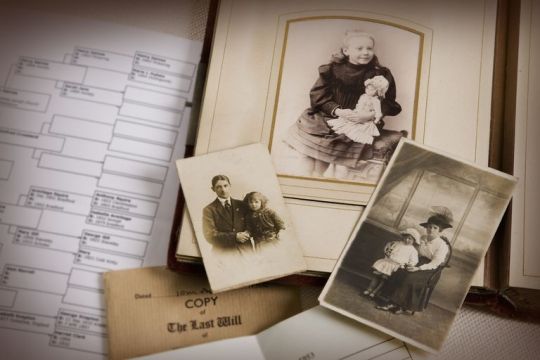
Your family’s history is so essential that since 2001, an entire month has been dedicated to discovering it! Researching your genealogy helps you to understand yourself and the world around you. It instills confidence, gives a deeper sense of purpose, and can even cue you into important medical knowledge. This October, take time to learn how your ancestor’s perseverance and bravery have impacted your life. Here are some ideas to get you started.
Interview older family members

Aging relatives are a wealth of knowledge. Their minds are full of insight about the past, and they often remember family stories from generations ago. Unfortunately, most people do not document bygone memories or family traditions. When an elderly family member perishes, details about a branch of your family tree remain a mystery.
This month, take some time to interview the oldest members of your family. Make a list of questions ahead of time to get you started, and then allow the conversation to flow naturally. Remember to utilize a voice recorder, laptop, or pen and paper to capture the discussion. We guarantee that you will learn something new about your ancestry, and at the very least, you will form a greater family bond.
Create a Family History Publication
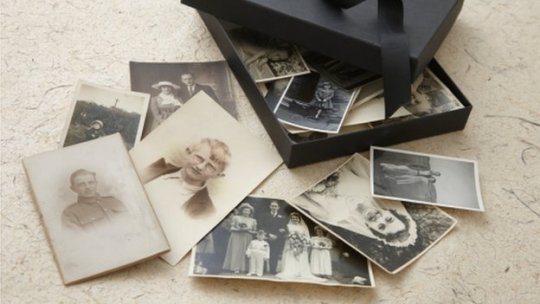
Before the days of cell phones, everyone stuck their photos into old shoeboxes or the family Bible. Because those pictures aren’t backed up anywhere or on the cloud, they are irreplaceable if lost or damaged.
Preserve your memories by allowing the SJR Research team to create a Family History Publication! We use oral history (like the stories you learned while interviewing your grandparents), our own genealogical research, and family photos to create a high-quality publication that can be passed down for generations! The books are available in an easy-to-share digital format or eye-catching print.
Apply to a hereditary society

It is empowering to find a community of people who understand your story. That is why groups like the Mayflower Society, Daughters of the American Revolution and Sons of the American Revolution are highly-sought after. Members of these societies feel like they are a part of something bigger than themselves, and they also reap the membership benefits of networking, special events, and organized trips.
However, these groups can be difficult to join because they require proof of a specific lineage. That is where we come in. We research your genealogy to verify your descendants. Then, we collect, copy, and organize all of the information needed so that your application is submitted correctly the first time.
Make family recipes

Cooking is an expression of our culture. It allows us to share a part of ourselves with others and gives us a steady reminder of traditions. Many of us have inherited great-grandma's antique notecards, but have we ever tried to make one of the dishes? Pull out those recipes and get cooking! The process will connect you to past relatives; plus, you may discover a new favorite meal!
If you don’t have family recipes, search for traditional meals from your ancestor’s homeland. For example, if you are of German heritage, try making Kartoffelpuffer, a shallow, fried, potato pancake, for breakfast. If your descendants came from Ireland, treat your family to some bangers and mash! We’re betting there will be no complaints about sausage and mashed potatoes for dinner.
Learn your genealogy

Discovering your family history is exhilarating. That’s why companies like Ancestry and 23 and Me are so popular! However, not everyone feels comfortable submitting their DNA to corporations, and most people crave more depth than a pie chart with percentages.
We specialize in uncovering stories of the past, no matter how little you know about your lineage. Our methods are research-based, which means that no DNA sample is required. We offer accuracy and privacy. Plus, we can show you copies of the documents we used to piece together your story. Everyone in your family will relish the proof of their heritage.
We celebrate Family History Month all year long!
Now is the perfect time to discover your history! Every family has untold stories of perseverance and bravery, and it’s our job to capture them. Our genealogical services will help you create lasting memories with family while preserving your legacy for the next generation. Visit our website to learn more.
3 notes
·
View notes
Text
Three Tucson Listings with a Rich, Hispanic Heritage

The Southwest is filled with Hispanic influences, from tantalizing restaurants and local festivals to historic communities. Though many of the neighborhoods are now ethnically diverse, the most notable districts are rooted in Latin culture.
In our latest post, we are taking a look at the history of three homes for sale in iconic neighborhoods of Tucson, Arizona. Each of these homes and their communities tells a worthwhile story that is rich in Hispanic heritage.
Elysian Grove Market

The Elysian Grove Market is a distinctive mud adobe home located in the El Hoyo neighborhood of Tucson. Jose Q. Trujillo built the structure in 1929 at the corner of W. Simpson Street and S. Samaniego Avenue. It quickly became one of the most important buildings in Barrio El Hoyo since it was the only local grocery store. Neighborhood members used the market as a central place for meeting up and socializing.
Barrio El Hoyo is historically significant to the Hispanic community. Tucson was founded by Spanish explorers in the late 18th century, but by 1890, Anglos owned 80% of the buildings in the city. Most of the Hispanic population lived south of downtown, where amenities were not easily accessible.
Leopoldo Carrillo owned most of the land in Barrio El Hoyo and developed it into Carrillo’s Gardens in the 1870s. Carrillo Gardens was a popular, scenic area that consisted of an artificial lake, caged animals and birds, and a park that was used for concerts and dances.
North of Carrillo Gardens was a field where University of Arizona football games were played and the first Tucson Air Show was held in 1911.
Emanuel Drachman purchased Carrillo Gardens after Carrillo died in 1903. He partnered with Alex Rossie to open the Elysian Grove amusement park. The park featured a half-mile speed track, a large pavilion, and a swimming pool, but financial issues shut the entire operation down in 1915.
Around this same time, housing developments began to pop up in El Hoyo, and construction continued well into the 1940s.
In 1960, the Elysian Grove Market closed. It was converted into three apartments and later a bed-and-breakfast. This one-of-a-kind property has a visually stunning exterior and modern interior that encompass the intriguing history of its charming neighborhood.
Dunbar/Spring adobe stunner

The beautiful Sonoran bungalow at 623 North 10th Avenue is a contributing building in the historic Dunbar/Spring neighborhood. Dunbar/Spring is one of the oldest neighborhoods in Tucson. It has a history that stretches back to the late 19th century.
From 1875 to 1909, the Court Street Cemetery took up half of the area that makes up Dunbar/Spring. In 1909, the cemetery closed, and the remains of the deceased were moved to Evergreen Cemetery. However, the movers may not have been as precise as they had hoped. In the 1920s, a resident of the area discovered the grave of a Civil War soldier in their backyard.
The southern edge of the neighborhood, from 6th Street to 2nd Street, was planned in 1904. The remainder of the locality was platted in 1917 after Court Street Cemetery closed.
623 North 10th Avenue, built circa 1911, is one of the oldest homes in the neighborhood, as most were constructed around 1920. The district is architecturally interesting, featuring a mix of Victorian, Sonoran, and Bungalow styles.
In 1912, around the same time that 623 North 10th Avenue was built, Arizona introduced mandatory school segregation. The Tucson School board converted a vacant building nearby at 215 E. Sixth Street into a school for Black American children. The school was named the Paul Lawrence Dunbar School after the famous poet. Soon after its founding, the school was moved to a larger building. It became integrated in 1951.
Today, Dunbar/Spring is a family-oriented, racially diverse neighborhood with beautiful homes that are within walking distance to downtown and the University of Arizona.
Armory Park Bungalow

The airy adobe bungalow, located at 705 6th Avenue in Tucson, is located in the notable Armory Park neighborhood. Armory Park is the first residential neighborhood in Arizona to be placed on the National Register.
Military members who guarded the Tucson Presidio were stationed in Armory Park during the 18th and 19th centuries. In 1873, the soldiers disbanded and were moved to Fort Lowell.
In 1913, the first armory in Arizona was constructed on the land, and the area became known as Military Plaza.
The Armory Park neighborhood was developed in the late 1800s due to the construction of the Southern Pacific Railroad. Many of its earliest residents were railroad workers who settled there because of its proximity to the tracks. Interestingly, some of the houses in the community still have two front doors from when homeowners rented rooms to railroad workers.
By the early 1900s, part of Military Plaza was converted into a public park and the Carnegie Library. The city purchased the rest of the Plaza.
Around this same time, the innovation of the trolley brought accessibility to the district. The trolley operated on a loop that started downtown and ran to 17th Street. The residents of Armory Park could quickly get to work, shops, churches, and schools because of this new form of travel.
Armory Park has been home to many notable residents over the years. In 1898, Henry Trost lived on South 6th Avenue, just two blocks from the listed home at 705 6th Avenue. George Roskruge, who was responsible for laying out the city, lived in Armory Park. Ben Daniels, the first U.S. Marshal of Arizona and the Sheriff of Tucson, lived at 647 South 4th Avenue. Daniels was a Rough Rider who is said to have entertained Theodore Roosevelt at his home.
Today, this neighborhood boasts an array of architectural styles, including Queen Anne, Greek Revival, and Territorial. The district is home to family-friendly attractions, including the Children’s Museum of Tucson and esteemed, historic schools.
Your property’s history awaits!
All older neighborhoods have a notable history that is waiting to be discovered! Today’s buyers want to live in a community with significance. Realtors miss out on sales when they fail to advertise their listings’ unique stories. Visit our website to see how our real estate history services help realtors sell homes faster and for a higher profit!
0 notes
Text
Barn Styles of the Northeastern United States
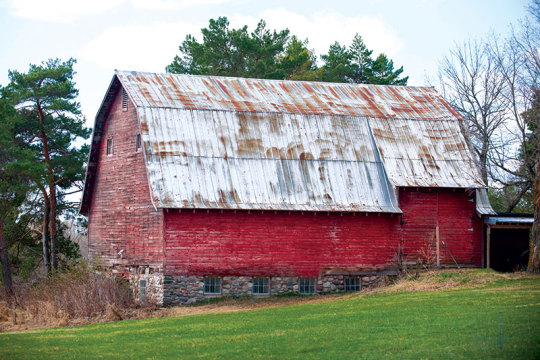
Barns are an essential piece of the American landscape. They embody our earliest traditions and teach us about what life was like for the first settlers. Though these iconic structures all served similar purposes, each type of barn tells its own story. Continue reading to discover three 18th century barn styles that were commonly found throughout the Northeast.
Bank Barns
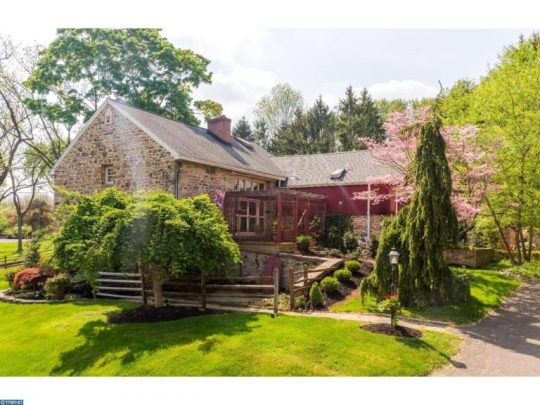
Bank barns are multi-level structures built into a hillside. By using the geography of the land, farmers could easily drive their wagons into the main level of the barn to drop off wheat or hay. Animals were kept in the lower level, and the upper level served as storage.
The main floor was extended to produce an overhang called a forebay for animals sheltering below. This allowed cows and horses to access fresh air while still giving them protection from rain and snow.
The design of bank barns first appeared in Switzerland in the 1500s. Farmers dealt with harsh weather in the high valleys by using the hills for added protection. European settlers found the design beneficial for northeastern American winters as well.
Bank barns were primarily found throughout New England and in Pennsylvania. Most of the original Pennsylvania settlers were from Germany, where the design of bank barns was also prominent. For this reason, bank barns are sometimes referred to as Pennsylvania-German bank barns or Sweitzer barns.
Today, surviving bank barns are either preserved by heritage societies or converted into homes. For example, the Leap Year Barn, built circa 1752 in Doylestown, Pennsylvania has been turned into an eye-catching, historic residence.
English Barns

Most people think of barns as unequivocally American, but when colonists built our country's first barns, they used design ideas from England. English barns were simple. Settlers constructed the open, windowless structures out of timber. They were only one level and did not have a loft or basement area. The barns did have a large door on one side that allowed entry for a wagon.
The barns were divided into animal and grain storage sections. In the middle of the barn, builders constructed a threshing floor to harvest their wheat. These unassuming barns were adequate for the small agricultural operations of most 16th and 17th-century farmers.
English barns prominent in the northeastern United States from the 1600 to-1900s. In the 1800s, farmers began to understand the value of sunlight for their animals, and consequently, added windows to the design.
Since English Barns were built centuries ago, it can be hard to find a historic one in good condition. The Kennedy Martin Stelle Farmstead in Basking Ridge, New Jersey, has a beautifully preserved 18th century English barn on its property. The Farmstead Arts organization in Basking Ridge uses it for events, workshops, and receptions.
Dutch Barns
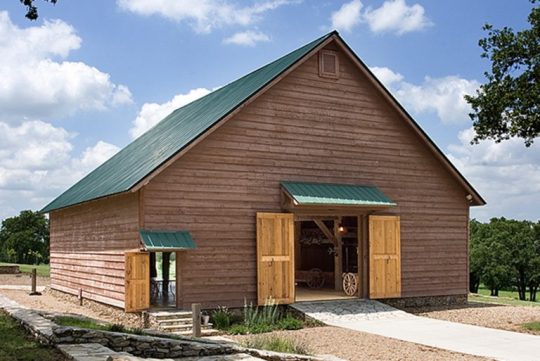
The earliest settlers from Holland settled along the Hudson River and developed a colony known as New Netherland. It encompassed parts of New York, Delaware, New Jersey, Pennsylvania, Maryland, and Connecticut. Throughout the Northeast, they constructed gable roof barns with complex interiors.
Though Dutch barns feature simple, horizontal siding on the exterior, the interior boasts an elaborate structural system. As explained by the National Parks Department, “Mortised, tenoned and pegged beams are arranged in "H"-shaped" units that recall church interiors, with columned aisles alongside a central space… The ends of cross beams projecting through the columns are often rounded to form tongues, a distinctive feature found only in the Dutch barn.”
Because the Dutch settlers were privy to virgin timber, Dutch barns are impressively sturdy. The overhead beams, called the anchor beams, often weigh over a ton!
It is difficult to find a well-preserved Dutch barn. The British burned down many of them during the 1780 raids, and others were destroyed to make way for modern structures. One stunning intact example is the Fort Hunter Dutch Barn, which was built in 1760 near the Erie Canal in upstate New York. In 2006, it was moved stick by stick to the Ten Triple X Ranch campus in Texas.
Partner with us for property history!
A house is not the only thing that makes a property significant. Some estates are deemed historic because of outbuildings, barns, and even garden beds. Visit our website to learn how we can help you discover the untold story behind your residence
0 notes
Text
Three of the Oldest Hispanic-Owned Businesses in America
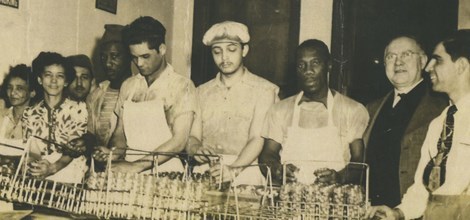
The Hispanic population has been an essential part of our country's story, even before its founding. Many of the first explorers to reach the United States were Spaniards, including Juan Ponce de Leon in 1521, Admiral Pedro Menendez de Aviles in 1565, and Conquistador Don Pedro de Peralta in 1609.
Though Hispanic Americans have had to overcome barriers rooted in discrimination for centuries, they remain almost 25% more likely to be entrepreneurs than the rest of the population. In honor of Hispanic Heritage Month, we are taking a look at three of the oldest Hispanic-owned organizations in American. Continue reading below to discover their stories.
Goya Foods reflects the American dream.
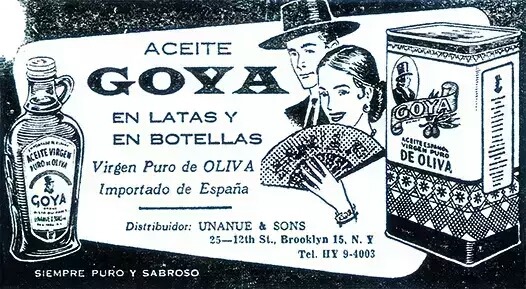
If your family has weekly taco nights, you have probably used some of Goya Foods' authentic packaged beans and rice varieties.
Goya Foods is one of the oldest foods companies in America. Frank Unanue, the President of Goya Foods, Florida, is a third-generation owner who is now witnessing the fourth generation join the family business.
Goya Foods’ story begins in the early 1930s, when Prudencio Unanue Ortiz, the grandfather of Frank Unanue, arrived in New York after emigrating from Spain and Puerto Rico.
Shortly after reaching the United States, Ortiz and his wife purchased the Goya brand for $1. Originally, Goya was primarily known for supplying sardines. The couple set up shop in Lower Manhattan, selling authentic Spanish foods, like olive oil, olives, and of course, sardines.
The Hispanic population continued to grow in the United States, especially after World War II when many Puerto Ricans entered New York. Goya increased their facilities to meet demand and included Caribbean goods, such as plantains, in their product line.
In 1974, Goya established its headquarters in New Jersey, where they currently remain today. Goya continues to offer popular cooking bases, packaged foods, Caribbean drinks, and award-winning olives oils that are beloved across the entire U.S. population.
El Charro claims its spot in history.
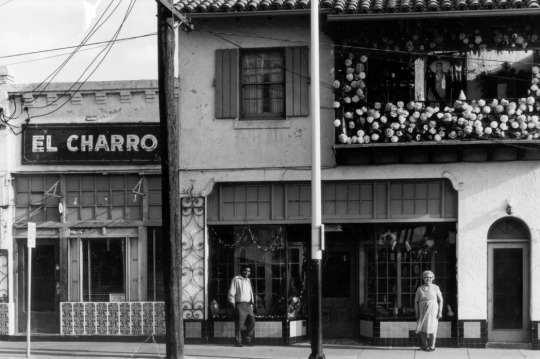
Speaking of Hispanic food products, El Charro, located in Tucson, AZ, is the oldest family-owned Mexican restaurant in the country.
El Charro was started by Monica Flin in 1922. Among other things, Monica is known for inventing the chimichanga. El Charro retells the hilarious story on their website:
“While frying her now famous El Charro ground beef tacos, she accidentally dropped a burro into the frying pan and when the oil splashed up she was about to lash out a common Spanish cuss word starting with “Ch” but because she was amongst her young nieces and nephews, changed it to “Chimichanga”, the equivalent of ‘thingamajig.’ Thankfully for all of us, Monica was a controlled and creative cuss.”
Monica immigrated from France to America in the late 1800s because her father, Jules, was commissioned to build the St. Augustine Cathedral. Jules is also responsible for constructing impressive buildings in downtown Tucson, including their family’s home, which is now where the Original Downtown El Charro Café is located.
Monica impressively wore most of the hats in her woman-owned business, acting as hostess, waitress, and chef! Monica steered her restaurant to become one of the most popular spots in the nation. Bon Appetite, Gourmet Magazine, and the New York Post are just some of the publications that have featured El Charro over the years.
The restaurant is celebrating its 99th anniversary with a special menu that includes their famous tamales, mole pipian, and sizzling rellenos.
San Antonio Hispanic Chamber of Commerce encourages others.

The last business we are focusing on empowers other Hispanic organizations to thrive. Created in 1929, the San Antonio Hispanic Chamber of Commerce was the first resource of its kind.
Don Enrique Santibanez, the Consul General of Mexico in San Antonio, organized what was originally named the Mexican Chamber. At first, the primary goal was to promote trade, policy, and culture between Mexico and America. However, it soon became evident that there was an immediate need to advocate for minority-owned businesses.
The Mexican Chamber of Commerce worked tirelessly over the next decade to creatively assist Hispanic businesses. In 1950, the organization commissioned a bridge on the West Side of San Antonio to make the area more accessible for those shopping downtown. Its creation was an economic boost to the local economy.
In 1988, the Board of Directors of the Mexican Chamber of Commerce drafted the language for the Small Business Economics Development Advocacy Program Ordinance, which the city of San Antonio passed with a 10-1 vote.
Today, the Mexican Chamber of Commerce, which has since been renamed the San Antonio Hispanic Chamber of Commerce, encourages Hispanic small business owners to share their voices and provides resources to help them grow and succeed.
Hispanic-owned businesses have a story to share.
As is the case with any minority-owned business, Hispanic companies have a powerful history. Their stories are full of overcoming societal barriers and blazing trails for the next generation.
The experts at SJR Research help business owners engage with their customers by advertising their journeys. Learn more about our corporate history services and how you can partner with us for your next milestone on our website.
0 notes
Text
Selling a Historic Home in the Fall
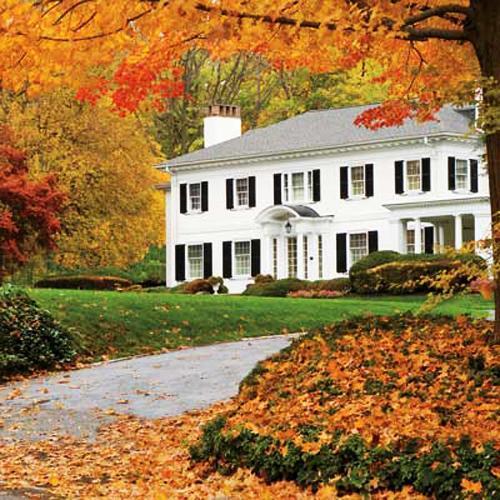
Real estate agents prefer to list houses in the summer, but when it comes to selling historic homes, we believe they shine the brightest in the fall. Older houses have a naturally friendly ambiance that bodes well with the coziness of autumn. Their architectural warmth makes the cooler days seem much more bearable. Continue reading below to discover tips for listing a historic home during the upcoming change of season.
Let the fall colors work for you.
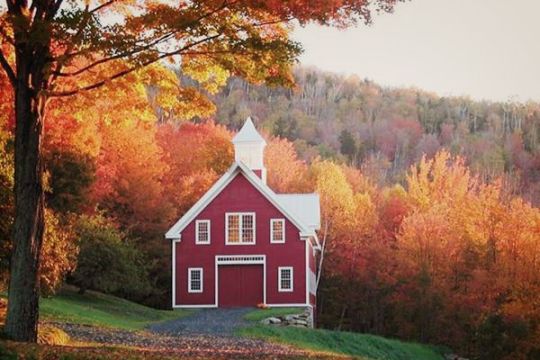
If you live in the Midwest or on the East coast, you know that the yellows and reds of autumn are a complementary backdrop to any historic home, but there are other things you can do to liven up the setting. Bring additional color to a front porch by adding a seasonal wreath, mums, or pumpkins.
Do not neglect the back of the house. Consider adding harvest-themed pillows to patio furniture or a scarecrow to garden beds.
High-quality pictures are an essential asset to a listing. If possible, take photos on a sunny day, when the blue sky will set off the vibrant foliage. Be sure to include any historic photos of the home in the listing as well.
A good education is not old news.

Buyers with children are often anxious about the possibility of switching to a new district. Ease their minds by advertising the advantages of the local schools. Note whether the bus stop is walkable to the home. Illustrate the intimate community setting by mentioning high school football games and fall festivals. Point out if the educational institutions have a history that is as rich as the home's.
Forget spring cleaning; it’s time for fall tidying!

Falling leaves mark an exciting change of season, but they also require more maintenance from homeowners. Buyers often fear that an older house comes with age-old problems. Be sure to ease their fears by tidying the landscape. Before listing the house, rake up extra leave in the yard and on the walkway. Clean out the gutters and take a broom to all of those pesky cobwebs that appear near the front door. Do not forget to also freshen the interior by removing any dust that has found its way into the decorative molding.
Create an inviting atmosphere.

Historic homes are warm and inviting. Can you think of anything more relaxing than curling up with a good book in a 19th-century sitting room? But, old homes also have a reputation for being drafty and racking up large energy bills. Add a comforting ambiance by igniting the fireplace and adding a few chunky knit throws to the décor.
Consider baking something delicious the day before the showing to add some sweet, homey scents into the air. If you lack the time or energy for baking, light some cinnamon candles; it is pumpkin spice season after all.
Brighten every room.

The days get shorter as fall progresses. Cloudy weather is not beneficial for showing any house, let alone a historic one. Older homes often have fewer windows than modern homes and a closed floor plan. Brighten the house even on the darkest of days by turning on every light. Aim floor lamps toward the ceiling or walls as opposed to downward. Try adding mirrors near light sources and cleaning the glass panes of the windows. If the seller is into heavy, dark furniture, consider staging the home with colorful paintings and beige or white accent pieces.
Win them over with treats

Remember the tip above about baking something delicious before a showing? Consider placing apple fritters or iced pumpkin cookies out for your visitors. Trust us, anyone will stick around when there are pastries involved.
Do you live in a historic district that draws out-of-state buyers? Treat them to apple cider and cinnamon donuts from the local cider mill. Make sure to leave a note explaining the history of the cider mill and its proximity to the house. It is just as important to attract non-local buyers to the prominence of the community as it is to the house.
Win them over with a story.
At SJR Research, we believe the fastest way to sell a historic home is to advertise its illustrious past. Today’s buyers love old homes for more than their unique architecture. They are enamored with the idea of being part of a larger story.
We partner with real estate agents to discover the histories behind homes for sale. We package the most exciting parts, like architectural details, prominent past owners, nearby historical events, and old photos into Property History One-Sheets. Visit our website to learn more about our historic real estate services.
0 notes
Text
Tips for Acquiring a Historic Brand

Recent acquisitions have taught us that now is the perfect time to give an old brand new life. Baby boomers are eager to make nostalgic purchases, while millennials have proven that they will spend more on products with a good reputation.
However, procurements are not without their challenges, and this is especially true when a historic brand is involved. Keep the below tips in mind to ensure that your relaunch is successful!
The old brand may have new problems.

Be cautious to not view your new acquisition through rose-colored glasses. As our society works to be more accepting and respectful of new views, an old product’s imagery may not land as well as it did in the past.
Over the last year, we have witnessed multiple organizations change the name and label of their racially rooted products. One such brand was Aunt Jemima, whose imagery originally featured a Black woman in minstrel dress. During its 130 year lifespan, the brand evolved Aunt Jemima’s look to remove the “mammy” characteristics, but in a statement last year, the CMO of Quaker Foods America recognized that their changes were not enough.
To find new inspiration, the brand only had to look further into its history. PepsiCo will now relaunch Aunt Jemima as Pearl Milling Company. It will surprise consumers to know that the Pearl Milling Company, founded in 1888 in St. Joseph, Missouri, was the original owner of the beloved pancaked mix that would later become Aunt Jemima.
As PepsiCo learned, you may need to do some digging to discover a history that is worth sharing. Understanding the past will help you navigate consumer opinion and future marketing campaigns.
Your target demographic may differ from the brand’s original audience.

Nostalgia does not always ensure a win with older audiences. Consumers are not quick to forget when a product left a bad taste in their mouths. Take, for example, the acquisition of Narragansett, a mid-twentieth century, widely-loved, New England beer. The new brand owners thought that their relaunch would land the best with New England Baby Boomers. After all, many of them grew up with the product in their homes.
However, the new owners did not realize that many in the Baby Boomer generation still held a grudge against the brand. The previous owners of Narragansett had moved production from Rhode Island to Indiana in 1982, which felt traitorous to New Englanders. Plus, Narragansett is associated with cheap ingredients and over-availability, sort of like today’s Coors Lite.
Unexpectedly, it is the craft beer-loving millennial generation that has taken to the Narragansett relaunch. Though most of them were not born when the beer departed the marketplace, they like the novelty of drinking something popular with their parents and grandparents.
To get Baby Boomers back on board, Narragansett has used grassroots marketing efforts, including attending beer festivals and regional events. They have even hired formal employees to validate that the new product is just as refreshing as its original.
Attracting an unexpected demographic is great news for your brand. Working with a corporate historian will help you know your new target audience ahead of time and assist you with ways to reclaim a lost market.
It’s ok to freshen up the image while maintaining a hold on the past.

You don’t have to tell us twice; a brand’s history is immensely valuable but so is a fresh perspective. Speaking of freshness, consider Old Spice’s comeback. You may know Old Spice from their comedic, modern ads, but the men’s grooming line was actually founded in 1937. The brand originally targeted American GI’s who had recently returned from war.
Their products became extremely popular until the 1970s when their target generation aged out. Old Spice tried to reposition itself to the next generation, but the younger demographic thought of the brand as outdated.
Old Spice floundered for the next twenty years until Proctor & Gamble purchased the brand in 1990. Proctor & Gamble saw Old Spice’s potential and created an advertising campaign that would succeed with the next generation where the past owners fell short. Through careful planning, Proctor & Gamble was able to capture the brand’s original purpose of making men feel unstoppable while adding a contemporary vibe.
To capture a new audience, Proctor & Gamble set their sights on teens that had not yet become loyal to a brand. They created a grassroots campaign, which included passing out samples at high school games and in 5th-grade gym classes. They also focused their marketing on athleticism. Today’s young men feel strong when they conquer a game, as opposed to men of the past who had just experienced conquering a war. Though the events are very different, the overall tone of victory is still present. These efforts have allowed Old Spice to reclaim a lost market.
Understanding your new brand’s history is key!
During the acquisition, you studied the brand’s copyright contract, organizational contacts, and integration plan, but have you taken time to discover its history? Unlocking a brand’s past is the key to uncovering future success.
Our corporate historians can unearth the full story of an organization, from its founding to where it stands in the present day. Visit our website to learn how we can help ensure your relaunch is lucrative.
0 notes
Text
Historic Home Heroes

Old homes have a special place in our hearts. Preserving them is essential for saving limited resources, reducing costs, and cementing the important stories of our past. Lately, the public has caught on to the valuable experience had by owning an old home, and historic house heroes can be found saving endangered structures across the country. Continue reading below to discover two such couples that have been integral in preserving the stories of two fascinating houses.
Danascara Place
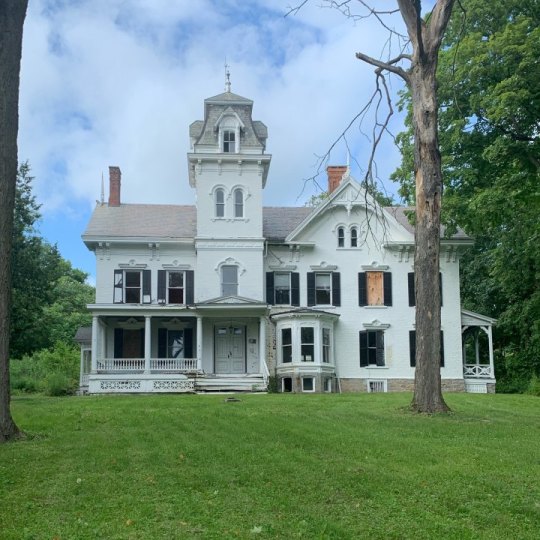
In 2018, Jessica Rhodes rescued a historic New York home, known as Danascara Place from foreclosure and has spent the last couple of years restoring it to its former glory. Through the rehab process, Jessica also got to work learning the home’s complete history, and its past is nothing but astonishing.
Frederick Harman Visscher, who was born to Dutch immigrants, purchased 1,000 acres of land, which include the property of Danascara Place, in Albany, New York in 1750. Frederick’s son, the younger Frederick, commanded the Third Regiment of the Tryon County Militia during the Revolutionary War.
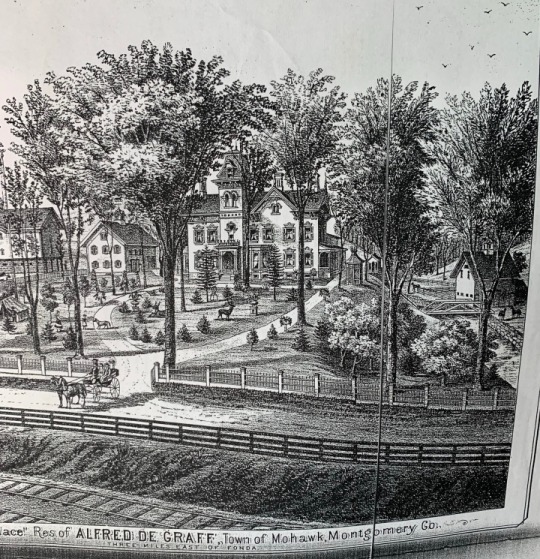
The Visschers became well-known for their support of the war, which caused tension between them and the other families in town. One of their neighbors, Sir John Johnson, led the Mohawk Valley raids of 1780 and attacked the Visscher family. American Indians left the younger Frederick Visscher for dead and burned down the original house on the property. However, Frederic survived rescued his brother and was treated to dinner by George Washington because of his heroism.
Around 1795, Frederick constructed the original section of Danascara Place, a 1 ½ story Federal home. After he died in 1809, Frederick’s son, Frederick Herman Visscher, inherited the property. Frederick Herman Visscher’s daughter, Gazena Catherine, married Judge Jesse D. DeGraff and had a son, Alfred DeGraff. Alfred enlarged the home, turning it into a 2 ½ story Italianate mansion.
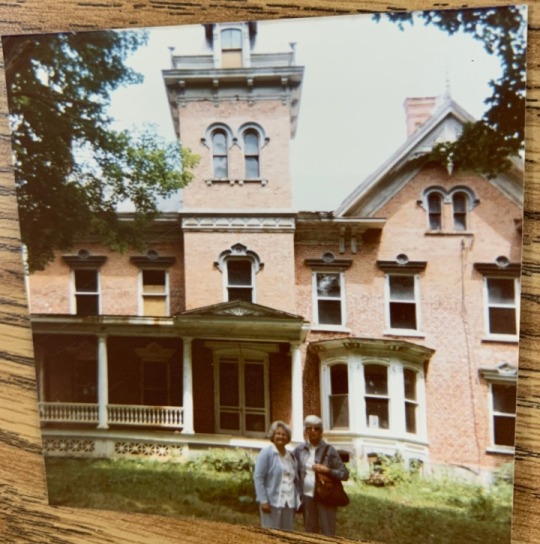
The DeGraff family remained in possession of the home until 1951. During the last 70 years, it changed hands many times. For a short while, previous owners transformed the mansion into small apartments. It has survived two foreclosures and a fire that destroyed part of an addition. We are thrilled that Danascara Place has finally landed in the hands of an owner that understands the importance of its past.
Duncan Manor
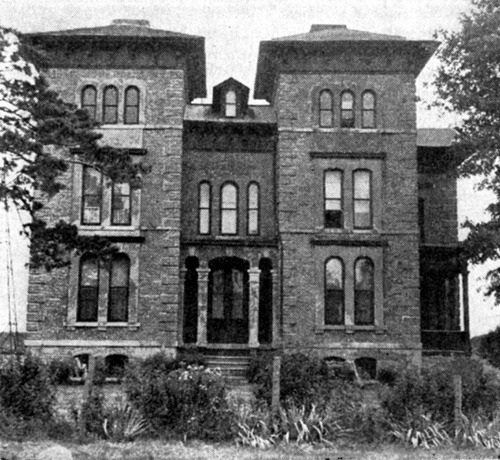
Cheap Old Houses is a blog, Instagram sensation, and now HGTV show that stars Ethan and Elizabeth Finkelstein. Elizabeth is an experienced historic preservationist and Ethan is a digital marketer. As lovers of old homes, they became frustrated with how difficult it is for shoppers to find old homes for sale online. To help save historic, abandoned homes in America, they started the websites CIRCA and Cheap Old Houses.
In 2014, Dave and Randi Howell were perusing the Cheap Old Houses website when they spotted and instantly fell in love with the nineteenth-century Italianate mansion, listed in Towanda, Illinois. After purchasing it, they established a nonprofit to help fund the needed restorations.
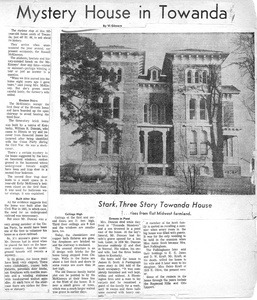
The home’s architecture is show-stopping and even caught the attention of FX producers, who used it as a filming location for the show Fargo, but beyond its gorgeous brick façade, the house also contains an intriguing past.
William R. Duncan, a pioneer farmer, built Duncan Manor circa 1870. Duncan was originally from Kentucky, but he was drawn to Central Illinois's fertile farmland. Supposedly, he built the remarkable home as a showplace that would be noticed by train travelers on their way to Chicago.

Unfortunately, Duncan never was able to fully enjoy the fruits of his labor. The home ended up costing more than he bargained, greatly depleting his income. Soon after the house was completed, his wife died of illness. A few years later, his teenage son drowned in a swamp near the home. In 1876, Duncan became suddenly ill while attending a nearby fair and died on his way back to the mansion.
Although unproven, some suspect that Duncan may have kept Black American servants in the lower level. The basement appears to be divided into living quarters, and the basement windows have iron bars. A trap door on the second floor that leads to a room in the basement has been noted by experts as an odd feature.

After the Duncans, various tenants rented the home. The Sullivan family purchased the house in 2008, planning to restore it to its original glory, but the vision has never come close to completion until now.
Are you ready to rescue an old home?
Whether you are a realtor, owner, or potential buyer, our firm offers services to assist your journey. We research the histories of homes and discover the stories behind previous owners, original land ownership, architectural significance, and more! Visit our website to learn more.
0 notes
Text
The History of your Favorite School Supplies
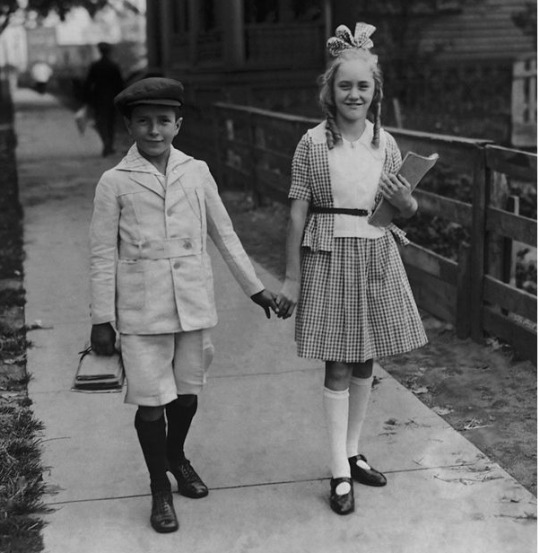
Each summer, parents perform the yearly ritual of back-to-school shopping. As you hurriedly check off the requested items from your child’s list, you may be wondering how we got to this place. Did children always care so much about what character was on their backpack? When did spiral notebooks become popular? We will answer all of these questions and more as we investigate the history of some of the most popular back-to-school items.
Backpacks were too cool for school.

It may be hard to imagine, but until 50 years ago, students carried their supplies in hand because they lacked the convenience of a backpack. Starting in the early 1900s, kids condensed their loads by fastening a strap of leather or cloth around stacks of books.
In 1938, Gerry Outdoors created the first backpack with a zipper, but he primarily sold it to hikers. Though some students adopted early backpacks for school, most still carried books around with a strap or their hands up until the 1970s.
In 1967, JanSport was established and began creating lightweight, nylon backpacks that were again marketed toward hikers. That same year, Gerry Outdoors also invented a smaller backpack that was similar to the JanSport model. College students saw the advantage of using a backpack instead of lugging their supplies by hand, and by the 1980s, backpacks were as popular as they are today!
Napoleon's army brought us the pencil.

An early version of the pencil, known as the stylus, was used by ancient Romans to write on papyrus. Over time, lead was incorporated into the stylus to produce a darker line.
In 1564, a large graphite deposit was discovered in Borrowdale, England. Originally, people believed it was a darker form of lead. Fast forward to 1795, Nicholas Jacques Conte, a scientist in the army of Napoleon Bonaparte, roasted a mixture of water, clay, and graphite to invent the modern pencil.
This new writing invention grew in popularity, spurring the Cumberland Pencil Company to open the first pencil factory in 1832. Originally, they sourced graphite from local mines. Since most mines are now closed, they secure graphite from Sri Lanka and other locations around the world. Although people now use pens and other writing devices for work, pencils are still a necessary tool for young students, artists, and designers.
Calculus used to be a lot harder.

Depending on your age, you may or may not remember hauling your Texas Instruments calculator to math class. If you’re in the latter group, we pity that you experienced calculus without the help of this trusted device.
Wilhelm Schickard invented the first early calculator, known as a calculating clock, in 1623. The calculating clock was able to multiple, add, and record up to 6 numbers.
The first commercially produced mechanical calculator was not invented until 1820, almost 200 years after Schickard’s device. Charles Xavier Thomas de Colmar created the arithmometer, the first machine that could add, subtract, multiply, and divide. Merchants sold the calculator all over the world, and it stayed in use until WWI.
The calculators that were invented during the first half of the 20th century were huge. In fact, the IBM 608 had to be housed in multiple cabinets. Finally, in 1970, Texas Instruments invented Cal Tech, the first handheld calculator. A year later, Busicom released the first handheld calculator with an LED display and a “calculator chip”. The Busicom LE cost $395 when it was first released. Because it was so expensive, the calculator came equipped with a wrist strap to mitigate falls.
Casio invented the first graphing calculator in 1985. Though the design has not changed much, companies have implemented advanced features over time. In 2003, Texas Instruments debuted touch functionality, and in 2010, Casio introduced the first graphing calculator in color.
Notebooks were not always so common.

Though paper has been around since 105 AD, the idea of compiling blank pages into a notebook occurred much later in history. During the 14th century, people created their notebooks at home by gathering papers, drawing ruled lines, and bounding them.
Thomas W. Holley of Massachusetts invented the legal pad in 1888. To sell paper pads to the public at a more reasonable price, Holley gathered paper scraps from local factories and stitched them together. In 1900, a judge asked if a margin could be drawn on the left side, which encouraged the creation of the legal pad.
Credit for modern spiral notebooks goes to Edward Podosek, an English inventor who patented the design around 1924. Both children and adults loved the convenience notebooks provided, which led companies like Mead and Moleskine to debut versions that are still beloved today.
We are the history experts!
Our firm uses history to inspire thought and ingenuity. We offer research services in genealogy, corporate history, property history, and much more. Visit our website to learn all that we do.
0 notes
Text
Genealogy can Change your Life
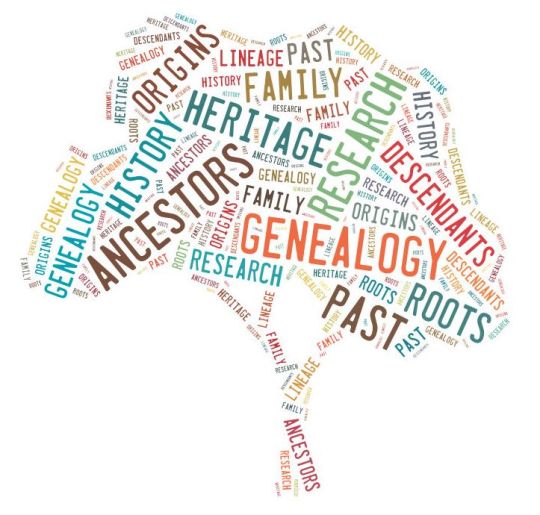
Genealogy is one of the hottest hobbies in America right now, and for a good reason. Learning your ancestry can help form your identity, explain the world around you, and give you stories to pass on to future generations.
Discovering your family’s narrative is exciting! Fitting together the missing pieces is like solving a very personal mystery, but for others, it goes deeper than that. Continue reading below for times when uncovering your family tree is crucial and even life-changing.
Uncover familial health issues

According to the Adoption Network, it is estimated that about 1 out of every 50 children are adopted in the United States. No matter how much you love your adopted family, most people become curious about their birth parents, especially as they get older. Even if you do not have an interest in building a relationship with your biological family, it is worthwhile to learn of any genetic health conditions. Alerting doctors of medical risks and modifying your lifestyle could be the key to a longer life.
Tracing your lineage is hard enough, even when aware of the names and birthdays of ancestors, but for those with limited knowledge of their birth parents, it can feel almost impossible. Whether you know a few details about your biological family or are starting from scratch, our experts can connect you to your past.
Acquire a second passport
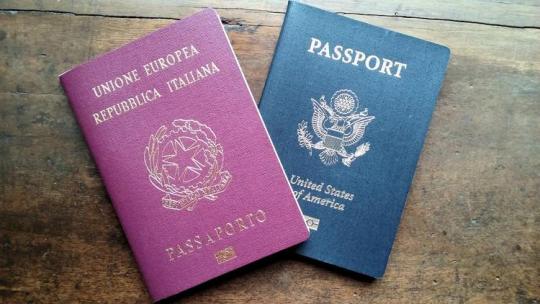
You may be eligible to become a citizen of a second country if your parent, grandparent, or in some cases, great-grandparent recently immigrated. This type of birthright is called citizenship by descent, and places like Ireland, Mexico, Poland, Italy, and Armenia offer it.
Having a second passport expands travel opportunities, can help reduce taxes and reconnects you to your roots. Citizenship by descent is one of the least expensive ways to gain a second passport, and future generations can enjoy the benefits! Who wouldn’t want easy access to another country based on their roots? To apply, you will need to prove your heritage and dig up your ancestor’s birth records, which is why working with a genealogist during this process can help to save you time and frustration.
Satisfy religious tenants
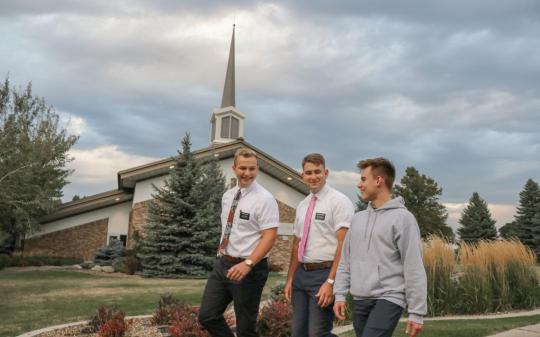
Mormons believe that baptism is necessary for salvation, and they follow the practice of baptizing the dead to ensure that even those who have passed on receive eternal life. For members of The Church of Jesus Christ of Latter-day Saints, tracing family trees to discover ancestors that died as non-Mormons is essential. Mormon families believe that baptized families can be together in the afterlife; therefore, discovering deceased members and performing temple rites provides peace and meaning to families here on earth.
The Church of Jesus Christ of Latter-day Saints has dedicated a lot of time and energy to creating genealogical resources for families, but for those who are new to the religion or lack an understanding of their past, discovering a family tree is not always so easy. Our genealogists can assist those searching for deceased ancestors, and we can fill you in on their past religious practices.
Legitimize land ownership
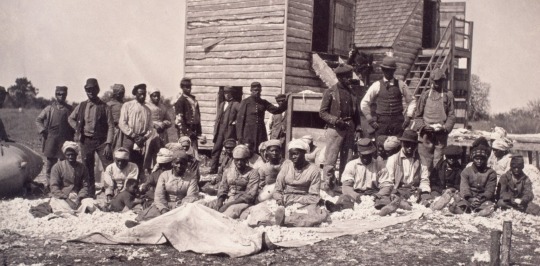
It is common for Black American families to own large pieces of land in the rural South. Some purchased property after gaining freedom from enslavement; others became landowners after the Civil War during the Homestead Act. Keeping land in the family was critical for Black families; they had spent generations denied the ability to pursue an unoppressed life. Owning land was not only financially life-changing; it was symbolic of their struggle.
However, PEW estimates that 85% of black landowners have lost their properties over the years, mainly due to improper contractual agreements. Original landowners often died without creating a will because they did not trust the courts to uphold their wishes. Other times, the land is divided among so many heirs that it becomes difficult to split tracts among the correct individuals.
During the last decade, new bills have passed that make it possible for descendants to gain legitimate titles, but the process becomes easier when you can prove heirship. Black Americans have a harder time piecing together their lineages than most. Throughout our country’s history, slavery and institutional racism have made their family records hard to attain. Our genealogical experts are sensitive to this issue and have experience finding the missing pieces for all families.
Your genealogy matters
For some of us, genealogy creates an exciting experience, but for others, it can generate a new start. No matter your background and the amount of information known about your relatives, our genealogists will use their access to databases and repositories to piece together your lineage.
Schedule a free consultation to learn how we can help here.
0 notes
Text
Revitalizing Old Buildings
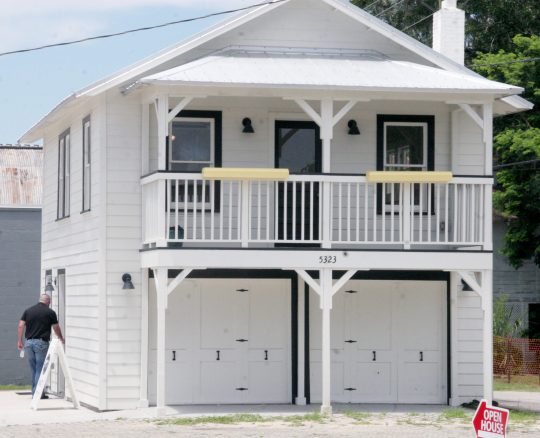
Across the United States, communities are realizing that preservation is key for beautifying neighborhoods and affordably making space for residential and commercial tenants. Continue reading below to discover the latest national rehabilitation projects and the tax incentive programs that are making it possible.
Restoration will help to increase traffic to a Florida downtown area.
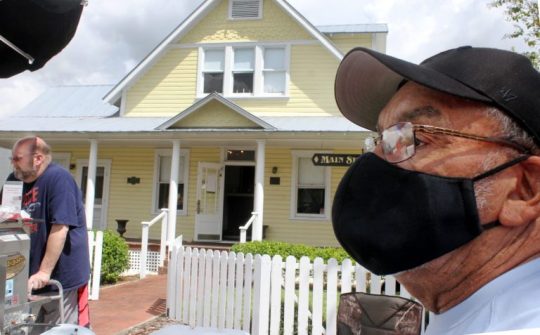
In Zephyrhills, Florida, local officials are hopeful that the restoration of two historic structures will bring new businesses to the downtown. One of the buildings is the Captain Jeffries House, which was constructed in 1911. Captain Jeffries was a journalist for the National Tribune. Jeffries was born in Pennsylvania and fought for the Union Army. After the war, he became interested in founding a colony for Union soldiers. He decided upon Zephyrhills so that past soldiers could live out their days, enjoying the warm sunshine.
The other building is the Carriage House on Ninth Street, which was built in 1940. This unique structure has folding garage doors, a second-floor balcony, and refurbished original windows. It also contains a second-floor one-bedroom apartment. Last year, the space was updated with new plumbing, heating, and electrical.
The city is looking at promoting the redevelopment of these properties even further by offering zero lease payments for a set amount of time and assistance to owners who will use the spaces to bring more visitors to the town.
Two abandoned Kansas City buildings go from blighted to inviting.

In Kansas City, Shomari Benton, Jason Parson, and Tim Duggan are renovating two abandoned buildings that were once the city’s water and street departments into office and retail development spaces. The buildings are located on the burgeoning north side, across the street from the county jail. The trio sees this as an opportunity to enhance the up-and-coming neighborhood. Benton and Duggan are local attorneys, while Parson works for an architectural design firm. Vine Street Brewing, the city’s first Black-owned brewery, will occupy space in one of the buildings.
The buildings have been abandoned since the 1970s; they were in such disarray that the city deemed them unsafe to enter. The structures required a long list of fixes, including new roofs, windows, and landscaping. However, the local business trio saw this as an opportunity to give back to the community and enjoy low leasing costs.
A historic church in Pennsylvania will advance equal housing.
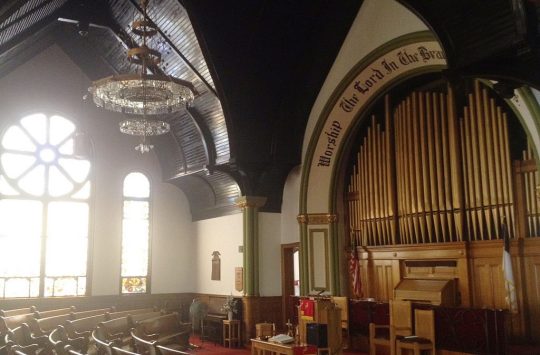
In Pennsylvania, an old, beloved church is finding a new lease on life. The First United Presbyterian Church of Braddock was built in 1893. It contains wood-framed stained glass windows and an organ and chandelier that were donated by Andrew Carnegie. Worshipers actively used the church until 2017.
Desperate for the building to not become an abandoned, forgotten structure, the remaining members of the congregation handed the property over to the Mon Valley Initiative, a group that provides community support. The Mon Valley Initiative was able to take advantage of the Historic Preservation Tax Credits to form a plan that will turn the church into mixed-income housing, including for those who are below the area median income line. The project will impart the same love from the congregation onto those who are most vulnerable in the community as well as save another historic structure from an unfair fate.
Tax incentives programs make rehabilitation possible.
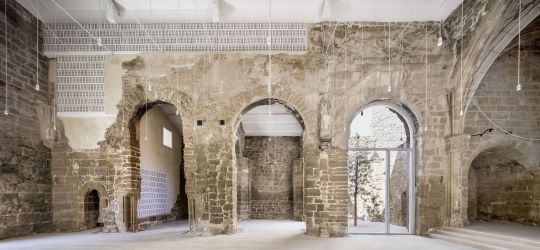
The restoration of old buildings would not be possible without outside financial support. There are both state and national programs available to encourage revitalization projects that restore communities. The Federal Historic Preservation Tax Incentives Program is eligible for income-producing, non-residential properties and offers 10% or 20% tax credits. The National Park System states that “It has leveraged over $102.64 billion in private investment to preserve 45,383 historic properties since 1976.”
Most states have some type of tax credit incentive in place. The Historic Preservation Tax Credit Program, which was started in 2013 in Pennsylvania, financially rewards taxpayers who are rehabilitating qualifying structures into income-producing properties. Likewise, Maryland offers a similar program that according to the Maryland Historical Trust, is “credited with rehabilitating about 4,400 historic buildings and creating some 25,000 jobs since its implementation in 1996.” Michigan recently reinstated its historic preservation program and will award up to $5M in tax credits for preserved residential properties.
History is valuable.
Every community across the United States has at least a few abandoned old homes or buildings, and some contain a multitude. Before you demolish an old structure, partner with us to learn if the building has a history worth saving. Visit our website to learn about our property history services.
0 notes
Text
The History of Gettysburg, Pennsylvania
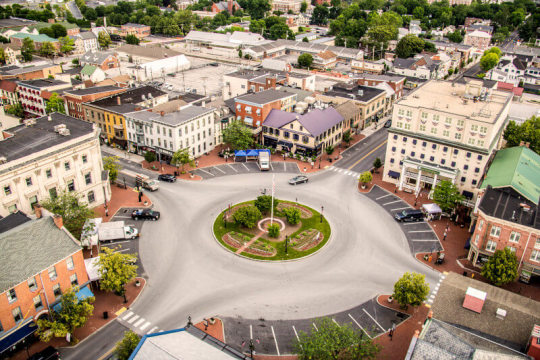
Gettysburg is an iconic city located in southern Pennsylvania. Notorious for the infamous battle that proved to be a turning point during the Civil War, this thriving town has a history beyond combat worth sharing. Continue reading below to discover the alluring beginnings of our hometown, Gettysburg, Pennsylvania.
Samuel Getty’s tavern paves the way for a city
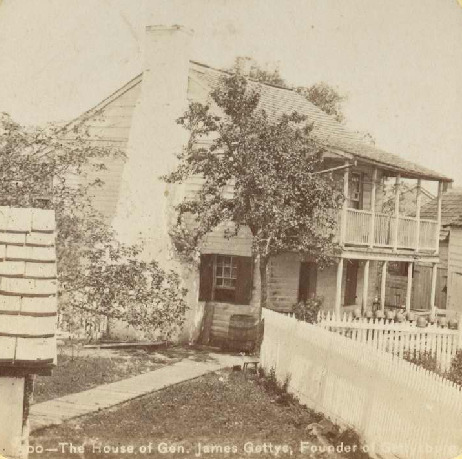
In 1736, William Penn purchased land in Adams County, then known as Marsh Creek, from the Iroquois Indians. The early settlers in the area had escaped Northern Ireland to avoid tensions with the English, though they now faced constant skirmishes between themselves and the American Indians. Raids and fighting were particularly heightened during the French and Indian War, which lasted from 1754-1763.
In 1761, an early settler by the name of Samuel Gettys opened a tavern in the area, though it is assumed that he was running his tavern business without a license for a while prior. A few years later, Samuel made the wise move of acquiring 381 acres of land around his tavern and opening a store on the property. Samuel’s land was strategically located near the intersection of two popular county roads, which led to George Washington using the area as a recruitment station for the Continental Army in 1775.
James Getty founds Gettysburg

A decade later, Samuel had racked up a lot of debt, supposedly from dealing Continental money. To make amends, the court ordered Samuel to sell some of his property. Thankfully, his ambitious son, James Gettys, saved his family's legacy by purchasing back 116 acres of his father’s land.
Shortly after, James Gettys laid out blueprints for a town on his family’s property. He planned for 210 lots that would surround a town square and his father’s tavern. The lots would be sold through a lottery system. Gettysburg, named after Samuel Gettys, became an official town on January 10, 1786.
At the time, Gettysburg was part of York County, but the town's population was growing large enough to require a new county. In 1800, the state legislature approved Adams County, which was named after President John Adams. James Gettys desperately wanted Gettysburg to be the county seat of the newly created Adams County. To successfully convince York County officials, James Gettys and the townspeople offered to pay $7,000 to cover the costs of county buildings.
The Battle of Gettysburg
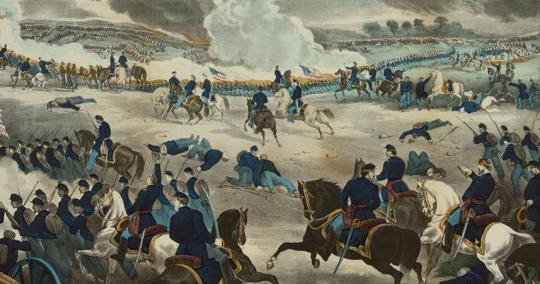
Over the next fifty years, the town flourished. It was home to both the Lutheran Theological Seminary and Gettysburg College. The approximately 2,400 citizens had a diverse set of skills, working as merchants, manufacturers, shoemakers, bankers, and tavern owners. The town enjoyed peaceful growth until the Civil War left its dark, historic mark.
In June of 1863, the Union Army of the Potomac, led by General George G. Meade, had recently been defeated by General Robert E. Lee and the Confederate Army at the Battle of Chancellorsville. Lee marched his 75,000 troops toward Central Pennsylvania to capture the North. While en route, Lee was advised that he was being tracked by Meade’s army. On July 1st, the Confederate and Union forces crossed paths in the town of Gettysburg. For three days, fighting ensued. By July 4th, 51,000 soldiers had died, marking the Battle of Gettysburg as the War’s bloodiest battle.
Lee’s defeat was a turning point for the War and successfully blocked the Confederate’s attempt to take the North. After the troops left Gettysburg, David Wills, a prominent attorney, was nominated to establish the Soldiers’ National Cemetery. Wills invited President Lincoln to Gettysburg in honor of the dedication. At Wills’ residence, Lincoln completed his famous Gettysburg Address.
Gettysburg in the modern-day
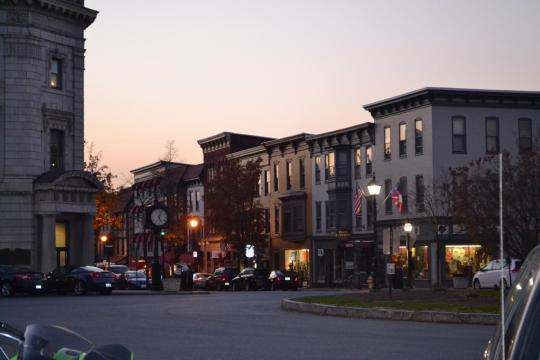
A few decades after the war, tourism exploded in Gettysburg. Manufacturers found steady work creating cannons and other battlefield reenactment equipment. Hotels, restaurants, museums, and souvenir shops abounded, as did transportation services.
The beginning of the 20th century saw the establishment of the Gettysburg Manufacturing Company, which specialized in residential furniture. Soon, other furniture companies opened nearby, and by the 1920s, the furniture manufacturing industry employed a large number of citizens. Despite the industry's success, all three of the major furniture companies had shuttered by the 1960s.
Today, Gettysburg is known for its bustling downtown, historical reenactments, and tours of homes and buildings that still contain the scars of Civil War fighting.
Your town’s history is worth more than a good story
A town’s history can significantly increase a home’s value. To learn more about your city’s past and our real estate history services, visit https://sjrresearch.com/real-estate-history/
1 note
·
View note
Text
The History of Squirrel Hill
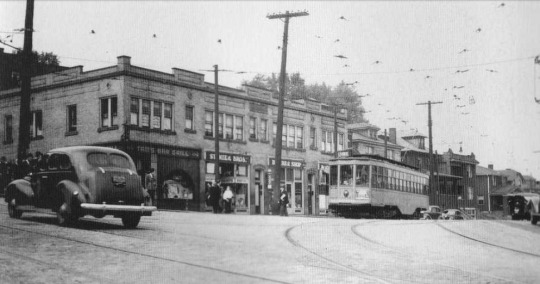
Knowing the history behind your property is essential for both appreciating its unique charm and selling it for a higher profit. When researching a home’s past, our team also investigates the history of the surrounding community, as it helps build a comprehensive picture of the property's story.
We’ve been privileged to recently uncover the fascinating pasts of houses in the historic city of Squirrel Hill, Pennsylvania. Continue reading below to discover how this once rural farming community evolved into an affluent, notable neighborhood.
The early days

Squirrel Hill received its name because of the abundance of grey squirrels in the area in the days of the early settlers. From the 11th to the 17th century, indigenous tribes, including the Monongahela, Shawnee, Lenape, and Iroquois inhabited the land. They hunted the hill's plentiful wildlife, which was drawn to a salt lick near the mouth of Nine Mile Run. Up until the beginning of the 19th century, American Indians and Europeans constantly faced confrontation. After the War of 1812, the American Indians were pushed westward due to disease, fighting, and treaties.
Even though nearby land in the valleys and riverbanks were experiencing industrial development and residential growth, Squirrel Hill remained a rural community until the late 1800s. Before that time, farmers, a handful of French and British hunters, and some coal miners were the only residents. After the French and Indian War, Irish, German and British colonists migrated to the area in search of free land and hunting opportunities.
Squirrel Hill’s first settlers

The first settlers to Squirrel Hill were a courageous group who risked their lives navigating the area’s high slopes and the often treacherous Monongahela River. Summerset, the original settlement, was established in c. 1760. It was nothing more than spread out log cabins along the Monongahela River on the southern end of the community. Eventually, it grew to include a church, school, gristmill, saltworks, and small quarry operation.
To navigate the area, people used American Indian trails, which have evolved to current roads, such a Saline Street and Shady Avenue. Two other settlements from the mid 18th century were established at the current intersection of Phillips Avenue and Beechwood Boulevard and near Forbes Avenue.
One of Squirrel Hill’s earliest settlers was Mary Girty Turner, who came upon the area in 1764 while trying to locate her sons, who had been kidnapped by Native Americans. Her youngest son, John Turner, was eventually granted 154 acres of land in Squirrel Hill in 1786.
A refuge from the city

By the mid-1800s, Squirrel Hill had become a desirable place to live. Affluent residents of Pittsburgh began buying up land from the original settlers to create spacious country estates. There were sometimes tensions between the farming families of the original settlers and the wealthy outsiders, but the Civil War helped to fill the divide, as men from all walks of life enlisted. During the war, Local men built Fort Black on the top of the hill to protect Pittsburgh from invasion.
After the war, Squirrel Hill continued to gain a reputation as a high-class refuge away from the city. Because trains could not yet make it up the hill, no factories were built there. The open spaces and clean air drew in wealthy industrialists. The sprawling country estates and original land tracts of the settlers were subdivided into large homes with spacious yards to accommodate the area’s slow growth.
The Hill becomes accessible

Technology and transportation in the 1800s rapidly increased the population of Squirrel Hill. In 1893, the electric trolley finally made the open land at the top of the Hill accessible. The sudden ease of transportation sparked growth in the business district at Forbes and Murray. Land speculators purchased all of the property near the new trolley routes and divided the land into residential lots.
Brown’s Bridge, which connected the steel town of Homestead with the East-end of Pittsburgh, was constructed in 1895. As a result, hundreds of large, beautiful homes were built on Shady Avenue and Denniston Street for those who managed the nearby mills.
Squirrel Hill in the modern-day

Squirrel Hill’s population continued to increase into the 1920s, as automobiles and the construction of the Boulevard of the Allies enabled buyers to live further away from their jobs. Most of the people moving to Squirrel hill at this time were Jewish. The new trolley connections allowed them to easily move from the north side of Pittsburgh to the Hill. The rest of the residents were mostly Scottish or Irish Presbyterians.
Today, Squirrel Hill is a diverse, lively community filled with historic homes, a sprawling business district, and two of Pittsburgh’s largest city parks. The city has been home to many celebrities over the years, including Fred Rogers (Mr. Rogers), and visited by past world leaders, including President Roosevelt and Prince Tsai Toa.
Visit our website to learn more about the history of your property and surrounding community.
0 notes
Text
Historic Dive Bars Across the U.S.
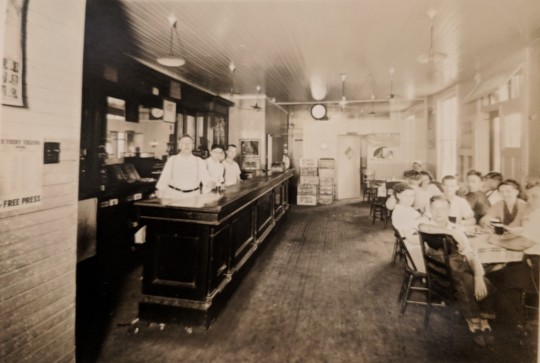
Old wood floors, growlers hanging from the ceiling, and a more than casual atmosphere – there is something about a dive bar that makes everyone feel at home. Dive bars remain unchanged from one generation to the next, which is part of their appeal. They provided fellowship to immigrants when they first arrived in the new world, celebrations for soldiers returning from war, and often a secret sense of comfort during prohibition. Here are four historic dive bars that are worth visiting on your next cross-country trip.
Lafitte’s Blacksmith Shop Bar – New Orleans
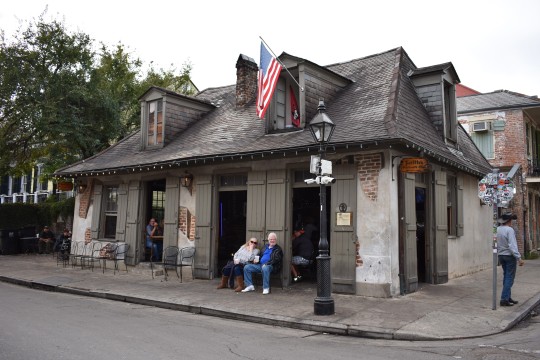
Lafitte’s claims to be the oldest structure used as a bar in the United States. It was built circa 1722 by Nicolas Touze and owned by the families of Simon Castillion and Captain Rene Beluche.
Until 1791, Jean and Pierre Lafitte’s used the building as a base for their Barataria smuggling operation. The Lafitte brothers operated a blacksmith shop in the bar as a front for selling the people and goods they ransacked on the ocean. Captain Beluche commanded the ship “Spy” which was part of Lafitte’s fleet.
The Lafitte brothers and their men aided Mayor General Jackson and the Americans at the Battle of New Orleans. In exchange for their role in defeating the British, they were granted amnesty for past offenses.
Today, the glow from votive candles and a stone fireplace bring this Bourbon Street gem to life while making you feel like a real pirate.
The Beachcomber – Wellfleet, Massachusetts
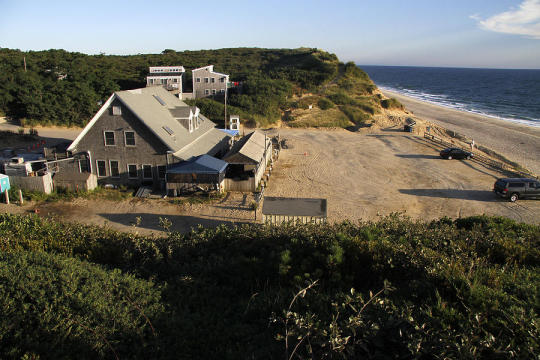
In 1872, the federal government initiated the construction of innovative lifesaving stations. The Wellfleet Beachcomber was built in 1897 as one of the first stations on the Outer Cape.
Russell Gallagher, who had fond vacation memories of the area, bought the station in 1953 and turned it into a small hotel. He owned the business for 25 years before selling it to the current owners.
Changes came in 1961 when President John F. Kennedy purchased thousands of acres of property along the Atlantic, thereby creating the Cape Cod National Seashore. The Beachcomber, by way of a grandfather clause, is one of only a few commercial properties that was allowed to remain open.
Today, the Beachcomber provides hospitable service and a unique, panoramic view of the Atlantic Ocean.
The Two Way Inn – Detroit, MI

This bar gets its name because it featured two entryways and two exits – providing an easy escape if the police or other sorts of trouble made an appearance. The Two Way Inn was built in 1873 and opened in 1876 by Colonel Philetus Norris, a hunter/trapper who served during the Civil War. Norris was responsible for a lot of the mapping of Yellowstone Park.
Northern Detroit was an untouched frontier when Norris came to town. He aptly named the area Prairie Town, which later became known as Norris Town. He built the saloon, which also served as a general store, stagecoach, railroad station, hotel, jail, and possibly brothel. During prohibition, a dentist owned the property; this allowed the bar to continue serving drinks by filling prescriptions for medical professionals and selling bootlegged liquor.
The same family has owned the bar since 1973. Mary Malak Aganowski inherited the bar from her father and continues to keep its history alive.
Salty Dawg Saloon – Homer, Alaska

The Salty Dawg was built in 1897 and served as one of the first cabins in the area. It was also used as the first post office, a railroad station, grocery store, and coal mining office.
A second building was constructed in 1909, which also functioned as a post office, schoolhouse, and market.
Chuck Abbott purchased the property in the 1940s and used it as an office for Standard Oil Company. He converted it into the Salty Dawg Saloon in 1957.
A few years after opening, in 1960, Earl Hillstrand, a former State Representative, purchased the bar. The property was dealt a blow in 1964 when what was known as the “Good Friday earthquake” shook the area. Hillstrand moved the bar to its present location and added a lighthouse to hide a water storage tank.
Dollar bills cover the walls and ceiling of this beloved bar’s interior. Years ago, sailors left money behind for the next boat to have a drink on them. The tradition continues to this day.
History matters in every industry
Whether you own a bar, manufacturing plant, or nonprofit, the history of your business is valuable. Partner with us to discover how you can use your past for future success. Learn more here.
0 notes
Text
Four Businesses that Witnessed the Birth of Our Nation

The lifestyle of 1776 is almost unrecognizable today. 40% of the working population were farmers as compared to 1.3% of the population today. $40,000 was all that it took for a family to be considered wealthy. The life expectancy was only 54 years for men and 56 for women due to the limited medical advancements.
Amazingly, with all that has changed over the last 245 years, some of America's oldest companies are still operating today. Continue reading below to discover four businesses that witnessed the birth of our nation.
Caswell – Massey
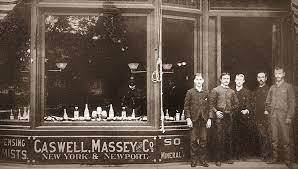
This upscale soap and fragrance shop was founded in 1752 by Scottish doctor, William Hunter. Doctor Hunter was an adventurous man who traveled to America at the age of 18. He opened Dr. Hunter’s Dispensary, a medical clinic for midwives, in Newport, Rhode Island. He is credited with inventing orange soda, which was used to improve the taste of medicines.
Soon, Dr. Hunter began importing and blending European fragrances to attract upper-class clientele. Some of his most notable early clients included George Washington, John Adams, and Dolly Madison. One of his most popular products was Number Six Cologne, which is still a top-seller in the present day. The scent is based on an English blend of botanicals, including cloves, orange peel, and pine.
Dr. Hunter was forced out of the area before the Revolutionary War because of his loyalist position, but he handed the shop over to his assistant before leaving.
In 1883, a Manhattan branch of the store opened, which was owned by businessmen John Rose Caswell and William Massey. Adoration for the products grew, which allowed for the expansion of locations across the country. Caswell – Massey products continued to attract notable Americans, including Annie Oakley, Edgar Allen Poe, and Judy Garland, and they remain ever-popular today.
The Griswold Inn
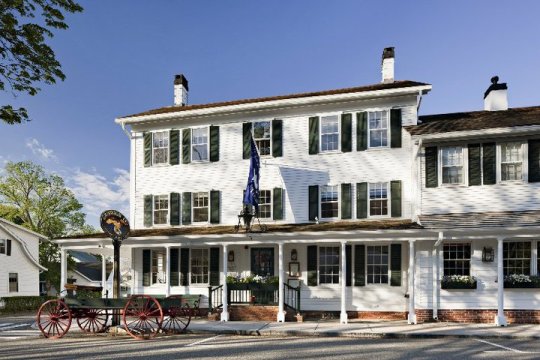
This historic inn and tavern was founded while America was gaining its independence. In 1776, Uriah Hayden of Essex was appointed to build the first Revolutionary warship, the Oliver Cromwell. The Haydens housed and fed all of the local workers, tradesmen, and politicians who were involved with the ship’s construction, thereby giving hospitable Griswold Inn its start.
After the war, Essex became an important travel destination, especially for steamboats as they journeyed between Hartford and New York. The Griswold Inn was a comfortable stay for those riding out a storm or enjoying a vacation.
In the 1840s, women of the Temperance Movement protested at the Inn on several occasions. For a time, the Inn obliged and supplied no alcohol, but as prohibition began, the Inn changed course and was fined and raided for serving spirits.
Today, the Griswold Inn is owned by the Paul family and still provides an authentic, comforting experience for locals and visitors.
Ames

In 1774, just two years before American gained its independence, Captain John Ames of Bridgewater, Massachusetts, began constructing the first metal shovels for the colonies.
Year later, in 1803, Captain John Ames’ youngest son, Oliver Ames, purchased property and manufacturing outbuildings in Easton, Massachusetts for a total of $1,600. It was there that Oliver Ames innovated his father’s business, patenting the trip hammer and manufacturing the first back-strapped shovels and wood handle shovel.
Americans trusted Ames shovels and used them during some of the country’s most historic moments. Laborers employed the shovels to construct the B&O Railroad in Baltimore and the Statue of Liberty in New York. Settlers from the Ohio Valley region faced the perilous journey West with these tools by their side. President Abraham Lincoln even requested that Ames shovels be supplied to the Union Army during the Civil War.
Today, Ames designs a wide range of tools that are known for their timeless, sturdy construction.
The Hartford Courant

In the age of the declining printed press, it can be hard to believe that one of the East Coast’s most popular newspapers was in circulation before the country's founding. The Hartford Courant is America’s oldest newspaper in continuous publication.
Thomas Green started The Courant in 1764. To improve sales, Green marketed clothing, spices, and other products near the newspaper office. He sold the Hartford Courant to Ebenezer Watson, his assistant. Watson operated the paper until he died of smallpox in 1777. Watson’s widow, Hannah, began running The Courant, which made her one of the first women publishers in the country.
The Courant was considered vital during America’s most important battles. This widely-read paper backed the Rebels during the Revolutionary War. During a skirmish, the paper mill was burned to the ground, causing The Courant to print new editions on wrapping paper until a new mill was constructed. President Lincoln visited the Courant in the mid-1800s, which influenced the paper’s choice to back him and his theology in the upcoming election.
The Courant has won countless national awards over the years and is owned by the Chicago-based Tribune Company.
Every business has a unique story!
Your legacy does not have to span over 245 years to possess a history worth sharing! New and old businesses alike have a past, and we would like to help you discover and market it. Visit our website to learn more about our corporate history services.
0 notes
Text
Why Your Business Needs a Company Archive

Today’s technology allows businesses to easily back up their most important resources, which leads many employers to question whether they need a company archive. The short answer is a resounding yes. While backing up data allows a user to restore it to a previously copied state after an incident, archives provide long-term data retention that is necessary for marketing, legal, and security reasons. Archives also enable organizations to free up storage, reduce costs, and preserve their oldest paper resources in mint condition. Continue reading below to discover the benefits of starting a company archive.
Market your heritage

The past few years have seen the branding pendulum swing from contemporary to heritage-based. You might recall the recent campaigns from Levi Jeans and Wells Fargo. Brands like these are experts at honoring the past and driving excitement for the future. How were these companies able to procure centuries-old brand assets in mint condition? Well, through their company archive!
Before computers, artists created logos and branding by hand, and photographers capture once-in-a-lifetime shots. Many organizations have these valuable resources tucked away in file folders, but over time, air and light can eat away at these assets, ruining the opportunity to utilize them for future campaigns. By archiving images and documents of the past, your organization can reference engaging, historical photos in new sales materials, teach employees about your history, and convey an interesting, unique brand image to customers.
Raise your company’s value

It might surprise you to know that historical elements are valued the same as tangible assets when archived. That is because archives management falls under the same category as facilities in the tax code. Often, this surprisingly means that you can eventually write-off archival costs.
Unlike most assets, archival resources go up in value over time! Historic elements like founding documents, old logos, and antiquated contracts can be worth a lot since they tell an important story from the past. This is especially true as your company hits milestones or if you launch a documentary that mentions said assets. Historic elements help to set your business apart from its competitors by proving a richer heritage and a higher company value.
Stay safe and compliant

We like to focus on the heritage benefits of archives, but it is important to note that there are legal and security reasons to have an organized system in place. Many organizations accidentally throw out paperwork that they are required to retain. If an incident arises, they might find themselves scrambling to locate necessary documents.
In the age of data breaches, some employers find that they haven’t misplaced their documents, but instead are the victims of cyber theft. By archiving essential paperwork, employers can rest easy knowing that their most critical assets are safe from the hands of hackers and unauthorized users.
Preserve emergency protocols

During COVID-19, many organizations found themselves scrambling to set up new safety rules and regulations. We would like to think that something of this magnitude will never happen again, but if there’s anything we know about history, it’s that it repeats itself.
Hopefully, a world pandemic will not return anytime soon, but in this fast-paced age of uncertainty, employers must be quickly prepared for anything. In the case of COVID-19, employers had almost no time to authorize new protocols. If your business ever finds itself in a similar situation, you will be able to easily draw from archived emergency orders of the past.
Invest in your future

We’ve mentioned that preserving historic assets is vital for marketing, but does an archive still make sense for a new company without historic branding? The most popular heritage brands of today would not shine as bright if someone hadn’t taken the time to save and protect the iconic elements of their past.
Looking far into the future can feel exhausting for a brand new business, but as time goes on and you begin hitting milestones, you will have wished that you had the original paperwork, photographs, and branding from your founding preserved and attainable. Do your future self a favor and get organized now.
We’ve got you covered
Our certified archive consultants have helped countless small businesses, nonprofits, and large corporations digitize their most important assets. Whether you want to preserve your heritage or protect your business from non-compliance, our specialists will help you set up an ongoing organizational system that continues to grow with you.
0 notes